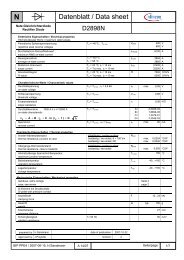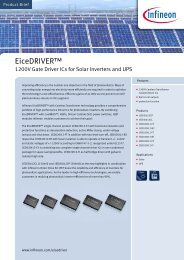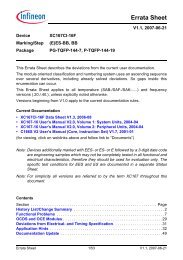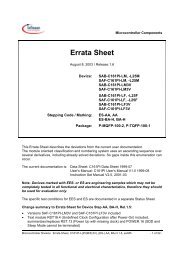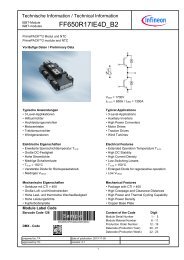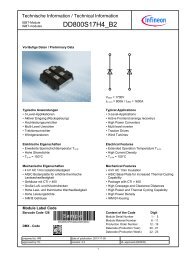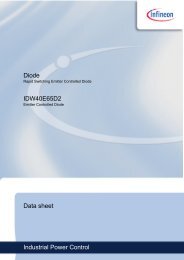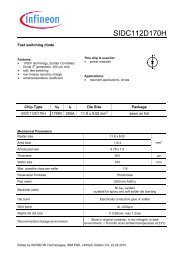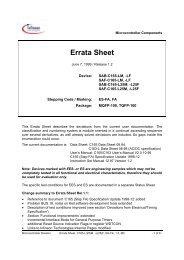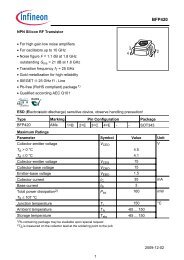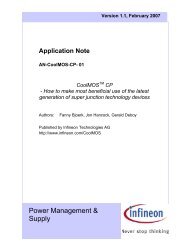TCA 785 Phase Control IC TCA 785 - Infineon
TCA 785 Phase Control IC TCA 785 - Infineon
TCA 785 Phase Control IC TCA 785 - Infineon
You also want an ePaper? Increase the reach of your titles
YUMPU automatically turns print PDFs into web optimized ePapers that Google loves.
<strong>TCA</strong> <strong>785</strong><br />
<strong>Phase</strong> <strong>Control</strong> <strong>IC</strong> <strong>TCA</strong> <strong>785</strong><br />
Pb-free lead plating; RoHS compliant<br />
Features<br />
● Reliable recognition of zero passage<br />
● Large application scope<br />
● May be used as zero point switch<br />
● LSL compatible<br />
● Three-phase operation possible (3 <strong>IC</strong>s)<br />
● Output current 250 mA<br />
● Large ramp current range<br />
●Wide temperature range<br />
PG-DIP-16-1<br />
Bipolar <strong>IC</strong><br />
Type Ordering Code Package<br />
<strong>TCA</strong> <strong>785</strong> Q67000-A2321 PG-DIP-16-1<br />
This phase control <strong>IC</strong> is intended to control thyristors, triacs, and transistors. The trigger pulses<br />
can be shifted within a phase angle between 0 ˚ and 180 ˚. Typical applications include<br />
converter circuits, AC controllers and three-phase current controllers.<br />
This <strong>IC</strong> replaces the previous types <strong>TCA</strong> 780 and <strong>TCA</strong> 780 D.<br />
Pin Configuration<br />
(top view)<br />
Pin Definitions and Functions<br />
Pin Symbol Function<br />
1 GND Ground<br />
2<br />
3<br />
4<br />
Q2<br />
Q U<br />
Q2<br />
Output 2 inverted<br />
Output U<br />
Output 1 inverted<br />
5 VSYNC Synchronous voltage<br />
6<br />
7<br />
I<br />
Q Z<br />
Inhibit<br />
Output Z<br />
8 V REF Stabilized voltage<br />
9<br />
10<br />
R9<br />
C10<br />
Ramp resistance<br />
Ramp capacitance<br />
11 V11 <strong>Control</strong> voltage<br />
12 C12 Pulse extension<br />
13 L Long pulse<br />
14<br />
15<br />
Q 1<br />
Q 2<br />
Output 1<br />
Output 2<br />
16 VS Supply voltage<br />
Semiconductor Group 1<br />
02.05
<strong>TCA</strong> <strong>785</strong><br />
Functional Description<br />
The synchronization signal is obtained via a high-ohmic resistance from the line voltage<br />
(voltage V5). A zero voltage detector evaluates the zero passages and transfers them to the<br />
synchronization register.<br />
This synchronization register controls a ramp generator, the capacitor C10 of which is charged<br />
by a constant current (determined by R9). If the ramp voltage V10 exceeds the control voltage<br />
V11 (triggering angle ϕ), a signal is processed to the logic. Dependent on the magnitude of the<br />
control voltage V11, the triggering angle ϕ can be shifted within a phase angle of 0˚ to 180˚.<br />
For every half wave, a positive pulse of approx. 30 µs duration appears at the outputs Q 1 and<br />
Q 2. The pulse duration can be prolonged up to 180˚ via a capacitor C12. If pin 12 is connected<br />
to ground, pulses with a duration between ϕ and 180˚ will result.<br />
Outputs Q 1 and Q 2 supply the inverse signals of Q 1 and Q 2.<br />
A signal of ϕ +180˚ which can be used for controlling an external logic,is available at pin 3.<br />
A signal which corresponds to the NOR link of Q 1 and Q 2 is available at output Q Z (pin 7).<br />
The inhibit input can be used to disable outputs Q1, Q2 and Q 1 , Q 2 .<br />
Pin 13 can be used to extend the outputs Q 1 and Q 2 to full pulse length (180˚ – ϕ).<br />
Block Diagram<br />
Semiconductor Group 2
<strong>TCA</strong> <strong>785</strong><br />
Pulse Diagram<br />
Semiconductor Group 3
<strong>TCA</strong> <strong>785</strong><br />
Absolute Maximum Ratings<br />
Parameter<br />
Symbol<br />
Limit Values<br />
min. max.<br />
Supply voltage VS – 0.5 18<br />
Output current at pin 14, 15 IQ – 10 400<br />
Inhibit voltage<br />
<strong>Control</strong> voltage<br />
Voltage short-pulse circuit<br />
Thermal resistance<br />
system - air Rth SA 80<br />
V6<br />
V11<br />
V13<br />
– 0.5<br />
– 0.5<br />
– 0.5<br />
Synchronization input current V5 – 200 ± 200<br />
Output voltage at pin 14, 15 VQ VS<br />
Output current at pin 2, 3, 4, 7 IQ 10<br />
Output voltage at pin 2, 3, 4, 7 VQ VS<br />
Junction temperature<br />
Storage temperature<br />
Tj<br />
Tstg – 55<br />
VS<br />
VS<br />
VS<br />
150<br />
125<br />
Unit<br />
V<br />
mA<br />
V<br />
V<br />
V<br />
µA<br />
V<br />
mA<br />
V<br />
˚C<br />
˚C<br />
K/W<br />
Operating Range<br />
Supply voltage VS 8 18<br />
Operating frequency f 10 500<br />
Ambient temperature TA – 25 85<br />
V<br />
Hz<br />
˚C<br />
Characteristics<br />
8 ≤ VS ≤ 18 V; – 25 ˚C ≤ TA ≤ 85 ˚C; f = 50 Hz<br />
Parameter<br />
Supply current consumption<br />
S1 … S6 open<br />
V11 = 0 V<br />
C 10 = 47 nF; R 9 = 100 kΩ<br />
Synchronization pin 5<br />
Input current<br />
R 2 varied<br />
Offset voltage<br />
<strong>Control</strong> input pin 11<br />
<strong>Control</strong> voltage range<br />
Input resistance<br />
Symbol<br />
min.<br />
Limit Values<br />
typ. max.<br />
Unit<br />
IS 4.5 6.5 10 mA 1<br />
I5 rms<br />
∆V5<br />
V11<br />
R11<br />
30 200 µA 1<br />
30<br />
75<br />
mV<br />
0.2 V10 peak V 1<br />
15<br />
kΩ 5<br />
Test<br />
Circuit<br />
4<br />
Semiconductor Group 4
<strong>TCA</strong> <strong>785</strong><br />
Characteristics (cont’d)<br />
8 ≤ VS ≤ 18 V; – 25 ˚C ≤ TA ≤ 85 ˚C; f = 50 Hz<br />
Parameter<br />
Symbol<br />
min.<br />
Limit Values<br />
typ. max.<br />
Unit<br />
Test<br />
Circuit<br />
Ramp generator<br />
Charge current<br />
Max. ramp voltage<br />
Saturation voltage at capacitor<br />
Ramp resistance<br />
Sawtooth return time<br />
I10<br />
V10<br />
V10<br />
R9<br />
tf<br />
10<br />
100<br />
3<br />
225<br />
80<br />
1000<br />
V2 – 2<br />
350<br />
300<br />
µA<br />
V<br />
mV<br />
kΩ<br />
µs<br />
1<br />
1.6<br />
1<br />
1<br />
Inhibit pin 6<br />
switch-over of pin 7<br />
Outputs disabled<br />
Outputs enabled<br />
Signal transition time<br />
Input current<br />
V6 = 8 V<br />
Input current<br />
V6 = 1.7 V<br />
V6 L<br />
V6 H<br />
tr<br />
I6 H<br />
– I6 L<br />
4<br />
1<br />
80<br />
3.3<br />
3.3<br />
500<br />
150<br />
2.5<br />
5<br />
800<br />
200<br />
V<br />
V<br />
µs<br />
µA<br />
µA<br />
1<br />
1<br />
1<br />
1<br />
1<br />
Deviation of I10<br />
R 9 = const.<br />
VS = 12 V; C10 = 47 nF<br />
Deviation of I10<br />
R 9 = const.<br />
VS = 8 V to 18 V<br />
Deviation of the ramp voltage<br />
between 2 following<br />
half-waves, VS = const.<br />
I10<br />
I10<br />
∆V10 max<br />
– 5<br />
– 20<br />
± 1<br />
5<br />
20<br />
%<br />
%<br />
%<br />
1<br />
1<br />
Long pulse switch-over<br />
pin 13<br />
switch-over of S8<br />
Short pulse at output<br />
Long pulse at output<br />
Input current<br />
V13 = 8 V<br />
Input current<br />
V13 = 1.7 V<br />
V13 H<br />
V13 L<br />
I13 H<br />
– I13 L<br />
3.5<br />
45<br />
2.5<br />
2.5<br />
65<br />
2<br />
10<br />
100<br />
V<br />
V<br />
µA<br />
µA<br />
1<br />
1<br />
1<br />
1<br />
Outputs pin 2, 3, 4, 7<br />
Reverse current<br />
<strong>IC</strong>EO<br />
10<br />
µA<br />
2.6<br />
VQ = VS<br />
Saturation voltage<br />
IQ = 2 mA<br />
Vsat 0.1<br />
0.4<br />
2<br />
V<br />
2.6<br />
Semiconductor Group 5
<strong>TCA</strong> <strong>785</strong><br />
Characteristics (cont’d)<br />
8 ≤ VS ≤ 18 V; – 25 ˚C ≤ TA ≤ 85 ˚C; f = 50 Hz<br />
Parameter<br />
Outputs pin 14, 15<br />
H-output voltage<br />
– I Q = 250 mA<br />
L-output voltage<br />
IQ = 2 mA<br />
Pulse width (short pulse)<br />
S9 open<br />
Pulse width (short pulse)<br />
with C12<br />
Internal voltage control<br />
Reference voltage<br />
Parallel connection of<br />
10 <strong>IC</strong>s possible<br />
TC of reference voltage<br />
Symbol<br />
V14/15 H<br />
V14/15 L<br />
tp<br />
tp<br />
VREF<br />
αREF<br />
min.<br />
VS – 3<br />
0.3<br />
20<br />
530<br />
Limit Values<br />
typ. max.<br />
VS – 2.5<br />
0.8<br />
30<br />
620<br />
VS – 1.0<br />
2<br />
40<br />
760<br />
Unit<br />
V<br />
V<br />
µs<br />
µs/<br />
nF<br />
2.8 3.1 3.4 V 1<br />
2 × 10 – 4 5 × 10 – 4 1/K 1<br />
Test<br />
Circuit<br />
3.6<br />
2.6<br />
1<br />
1<br />
Semiconductor Group 6
<strong>TCA</strong> <strong>785</strong><br />
Application Hints for External Components<br />
Ramp capacitance<br />
Triggering point<br />
Charge current<br />
min<br />
max<br />
C10 500 pF 1 µF 1)<br />
tTr =<br />
I10 =<br />
V11 × R9 × C10 2)<br />
VREF × K<br />
VREF × K 2)<br />
R9<br />
The minimum and maximum values of I10<br />
are to be observed<br />
Ramp voltage<br />
V10 max = VS – 2 V V10 =<br />
VREF × K × t<br />
R9 × C10<br />
2)<br />
Pulse Extension versus Temperature<br />
1) Attention to flyback times<br />
2) K = 1.10 ± 20 %<br />
Semiconductor Group 7
<strong>TCA</strong> <strong>785</strong><br />
Output Voltage measured to + VS<br />
Supply Current versus Supply Voltage<br />
Semiconductor Group 8
<strong>TCA</strong> <strong>785</strong><br />
It is necessary for all measurements to adjust the ramp with<br />
the aid of C10 and R 9 in the way that 3 V ≤ Vramp max ≤ V S – 2 V<br />
e.g. C10 = 47 nF; 18 V: R 9 = 47 kΩ; 8 V: R 9 = 120 kΩ<br />
Test Circuit 1<br />
Semiconductor Group 9
<strong>TCA</strong> <strong>785</strong><br />
The remaining pins are connected as in test circuit 1<br />
Test Circuit 2<br />
The remaining pins are connected as in test circuit 1<br />
Test Circuit 3<br />
Semiconductor Group 10
<strong>TCA</strong> <strong>785</strong><br />
Remaining pins are connected as in test circuit 1<br />
The 10 µF capacitor at pin 5 serves only for test purposes<br />
Test Circuit 4<br />
Test Circuit 5 Test Circuit 6<br />
Semiconductor Group 11
<strong>TCA</strong> <strong>785</strong><br />
Inhibit 6 Long Pulse 13<br />
Pulse Extension 12 Reference Voltage 8<br />
Semiconductor Group 12
<strong>TCA</strong> <strong>785</strong><br />
Application Examples<br />
Triac <strong>Control</strong> for up to 50 mA Gate Trigger Current<br />
A phase control with a directly controlled triac is shown in the figure. The triggering angle of<br />
the triac can be adjusted continuously between 0˚ and 180˚ with the aid of an external<br />
potentiometer. During the positive half-wave of the line voltage, the triac receives a positive<br />
gate pulse from the <strong>IC</strong> output pin 15. During the negative half-wave, it also receives a positive<br />
trigger pulse from pin 14. The trigger pulse width is approx. 100 µs.<br />
Semiconductor Group 13
<strong>TCA</strong> <strong>785</strong><br />
Fully <strong>Control</strong>led AC Power <strong>Control</strong>ler<br />
Circuit for Two High-Power Thyristors<br />
Shown is the possibility to trigger two antiparalleled thyristors with one <strong>IC</strong> <strong>TCA</strong> <strong>785</strong>. The trigger<br />
pulse can be shifted continuously within a phase angle between 0˚ and 180˚ by means of a<br />
potentiometer. During the negative line half-wave the trigger pulse of pin 14 is fed to the<br />
relevant thyristor via a trigger pulse transformer. During the positive line half-wave, the gate of<br />
the second thyristor is triggered by a trigger pulse transformer at pin 15.<br />
Semiconductor Group 14
<strong>TCA</strong> <strong>785</strong><br />
Half-<strong>Control</strong>led Single-<strong>Phase</strong> Bridge Circuit with Trigger Pulse Transformer and Direct<br />
<strong>Control</strong> for Low-Power Thyristors<br />
Semiconductor Group 15
<strong>TCA</strong> <strong>785</strong><br />
Half-<strong>Control</strong>led Single-<strong>Phase</strong> Bridge Circuit with Two Trigger Pulse Transformers for<br />
Low-Power Thyristors<br />
Semiconductor Group 16



